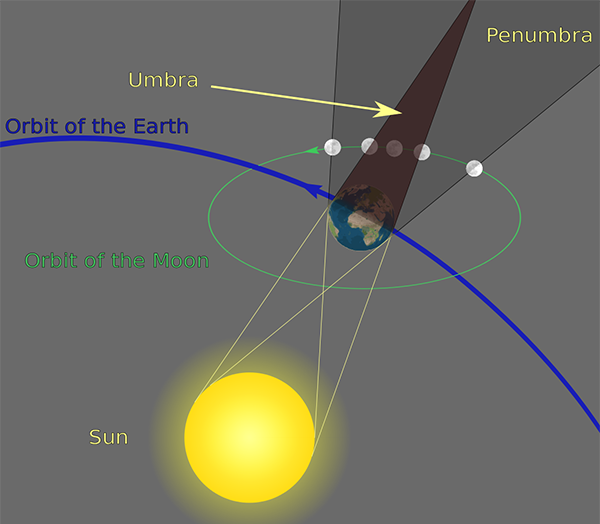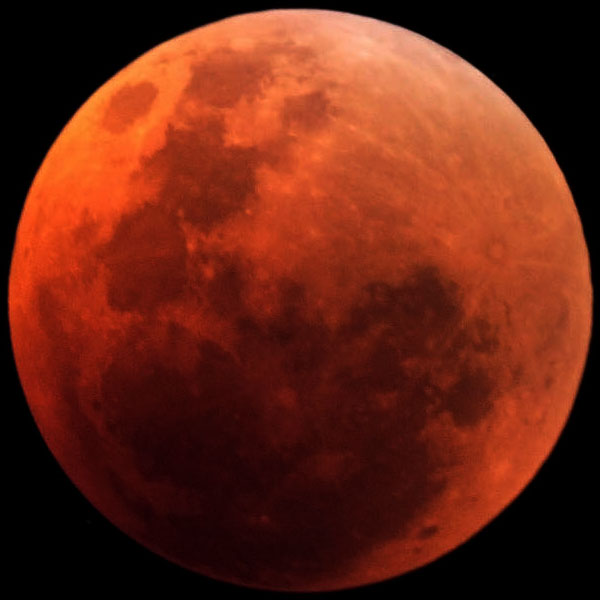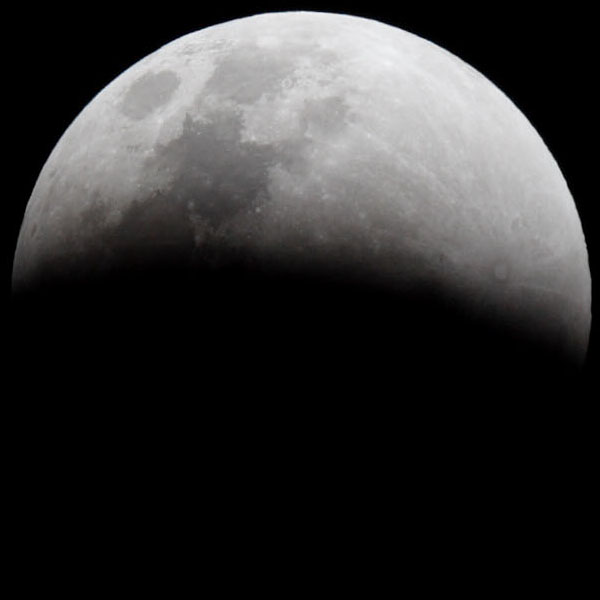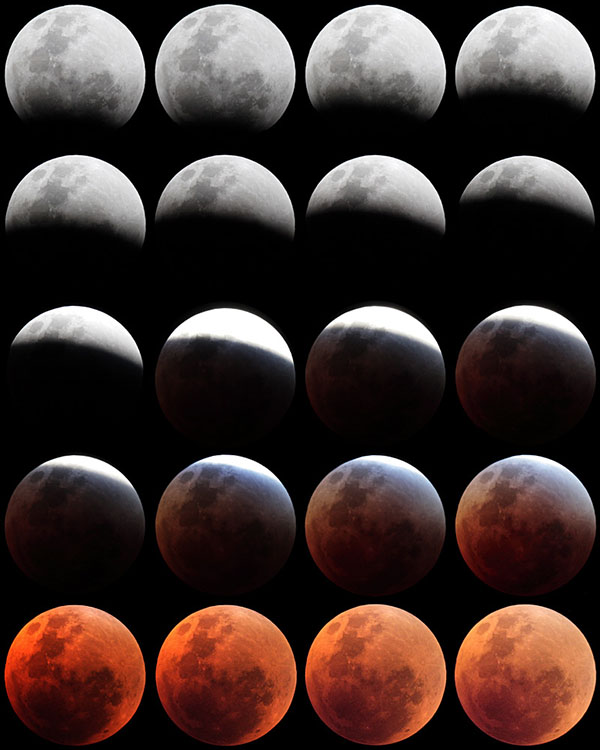Lunar eclipses occur when the Earth is positioned between the sun and the moon, so that the Earth blocks some or all of the sunlight from directly reaching the moon. Because of the relative sizes of the sun, Earth, and moon, and their distances from one another, the Earth’s shadow is large enough to completely cover the moon.
To talk about eclipses, we need to define some terms. The sun is a large, extended source of light, not a point source, so the shadows that objects cast in sunlight have two components: the umbra, where light from the sun is totally blocked, and the penumbra, where light from the sun is partially blocked.
When the moon passes entirely inside the Earth’s umbra, that is a total lunar eclipse. Although no sunlight reaches the moon directly, the moon is not completely dark, because some sunlight refracts (bends) through the Earth’s atmosphere and reaches the moon. This light is red for the same reason that sunsets on Earth tend to be red: the atmosphere scatters blue light more easily than red, so red light penetrates large distances of air more easily. This is why during a total lunar eclipse the moon is a reddish colour. Although a totally eclipsed moon looks bright enough to our eyes, it’s actually very dark compared to a normal full moon. Our eyes are very good at compensating for the different light levels without us being aware of it.
The amount of refracted light reaching the moon depends on the cleanliness of the Earth’s atmosphere. If there have been recent major volcanic eruptions, then significantly less light passes through to reach the moon. The brightness of the moon during a total lunar eclipse can be measured using the Danjon scale, ranging from 0 for very dark eclipses, to 4 for the brightest ones. After the eruption of Mount Pinatubo in the Philippines in 1991, the next few lunar eclipses were extremely dark, with the eclipse of December 1992 rating a 0 on the Danjon scale.
When the moon is only partly inside the Earth’s umbra, that is a partial lunar eclipse. A partial phase occurs on either side of a total lunar eclipse, as the moon passes through the Earth’s shadow, and it can also occur as the maximal phase of an eclipse if the moon’s orbit isn’t aligned to carry it fully within the umbra. During a partial eclipse phase, you can see the edge of the Earth’s umbral shadow on the moon.
Lunar eclipses can only occur at the full moon – those times when the sun and moon are on opposite sides of the Earth. The moon orbits the Earth roughly once every 29.5 days and so full moons occur every 29.5 days. However, lunar eclipses occur only two to five times per year, because the moon’s orbit is tilted by 5.1° relative to the plane of the Earth’s orbit around the sun. This means that sometimes when the moon is full it is above or below the Earth’s shadow, rather than inside it.
Okay, so what can lunar eclipses tell us about the shape of the Earth? A lunar eclipse is a unique opportunity to see the shape of the Earth via its shadow. A shadow is the same shape as a cross-section of the object casting the shadow. Let’s have another look at the shape of Earth’s shadow on the moon, in a series of photos taken during a lunar eclipse:
As you can see, the edge of the Earth’s shadow is curved. The fact that the moon’s surface is curved doesn’t affect this, because we are looking from the same direction as the Earth, so we see the same cross-section of the moon. (Your own shadow looks the shape of a person to you, even if it falls on an irregular surface where it looks distorted to someone else.) So from this observation we can conclude that the edge of the Earth is rounded.
Many shapes can cause a rounded shadow. However, if you observe multiple lunar eclipses, you will see that the Earth’s shadow is always round, and what’s more, it always has the same radius of curvature. And different lunar eclipses occur at any given location on Earth with the moon at different points in the sky, including sometimes when the moon is not in the sky (because the location is facing away from the moon). This means that different lunar eclipses occur when different parts of the Earth are facing the moon, which means that different parts of the Earth’s edge are casting the shadow edge on the moon. So from these observation, we can see that the shape of the shadow does not depend on the orientation of the Earth to the moon.
There is only one solid shape for which the shape of its shadow doesn’t depend on the object’s orientation. A sphere. So observations of lunar eclipses show that the Earth is a globe.
Addendum: A common rebuttal by Flat Earthers is that lunar eclipses are not caused by the Earth’s shadow, but by some other mechanism entirely – usually another celestial object getting between the sun and moon and blocking the light. But any such object is apparently the same colour as the sky, making it mysteriously otherwise completely undetectable, and does not have the simple elegance of explanation (and the supporting evidence from numerous other observations) of the moon moving around the Earth and entering its shadow.




How about the other Flat Earthers who claim the Moon is just a hologram and is entirely fake, including the shadow?
I mean, you’re an optics-specialising physicist, so you know better than I do that holograms don’t work like that. I just thought I’d mention it.
By the way, lunar eclipses are a great primary-school science topic (since you mention advising a science club). The kids can act one out in a darkened room with nothing but a lamp and some balls.
Glad you’re feeling better.
People who claim the moon is a hologram, don’t understand holograms.
Plus, of course, they are then left to explain why the hologram of the moon exactly correlates to the tides, and why tides exist at all.
Completely tangential to the main issue, all your Moon photographs look unsettlingly odd to me, even though I’ve been actively interested in Astronomy for over 50 years. This is of course because I live in the UK and (presumably) your photos are all taken in Australia, so each of us sees the Moon as what to the other looks upside down.
Yes, the moon always looks strange to me when I visit the northern hemisphere. 🙂
What does the moon look like at the equator? Sideways?
I’ve been reading “Chasing Shadows” by Clemency Montelle, a history of eclipse prediction. Interestingly, the Babylonians were successful at predicting lunar and solar eclipses, seemingly without a physical model of any sort to explain the phenomena. The Greeks, on the other hand, developed extensive physical models show that the Earth was approximately spherical, the relative size of the Earth and the moon, parallax, the tilt of the lunar orbit compared to solar orbit. There is some debate about how much was developed in specific generations of mathematicians (did Hippachus develop some of the models or did Ptolomy?).
The Babylonians and Mesopotamians used eclipses as omens and had tables stating that if an eclipse occurred at a particular time it meant something. Curiously, some of their tables list meanings for a lunar eclipse occurring other than at the center of the lunar month, which is obviously impossible. The Greeks, in adopting some of the ominous tradition, dropped these.
Sorry, but I am with the Babylonians on this one. A lunar eclipse not during a full moon is decidedly ominous.
“The moon’s orbit is tilted by 5.1° relative to the plane of the Earth’s orbit around the sun. This means that sometimes when the moon is full it is above or below the Earth’s shadow, rather than inside it.”
OMG thank you, it had never made sense to me why we don’t have lunar eclipses every time there’s a full moon, or solar eclipses every time there’s a new moon.